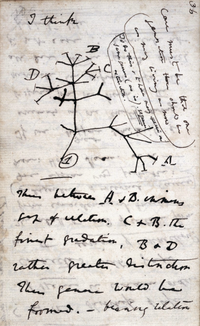
Photo from wikipedia
There is currently no framework for identifying genes that contribute to molecular divergence between microbial populations in different environments. To address this absence, we developed a null modeling approach to… Click to show full abstract
There is currently no framework for identifying genes that contribute to molecular divergence between microbial populations in different environments. To address this absence, we developed a null modeling approach to describe the distribution of mutation counts among genes. ABSTRACT The degree to which independent populations subjected to identical environmental conditions evolve in similar ways is a fundamental question in evolution. To address this question, microbial populations are often experimentally passaged in a given environment and sequenced to examine the tendency for similar mutations to repeatedly arise. However, there remains the need to develop an appropriate statistical framework to identify genes that acquired more mutations in one environment than in another (i.e., divergent evolution), genes that serve as genetic candidates of adaptation. Here, we develop a mathematical model to evaluate evolutionary outcomes among replicate populations in the same environment (i.e., parallel evolution), which can then be used to identify genes that contribute to divergent evolution. Applying this approach to data sets from evolve-and-resequence experiments, we found that the distribution of mutation counts among genes can be predicted as an ensemble of independent Poisson random variables with zero free parameters. Building on this result, we propose that the degree of divergent evolution at a given gene between populations from two different environments can be modeled as the difference between two Poisson random variables, known as the Skellam distribution. We then propose and apply a statistical test to identify specific genes that contribute to divergent evolution. By focusing on predicting patterns among replicate populations in a given environment, we are able to identify an appropriate test for divergence between environments that is grounded in first principles. IMPORTANCE There is currently no universally accepted framework for identifying genes that contribute to molecular divergence between microbial populations in different environments. To address this absence, we developed a null model to describe the distribution of mutation counts among genes. We find that divergent evolution within a given gene can be modeled as the absolute difference in the total number of mutations observed between two environments. This quantity is effectively captured by a probability distribution known as the Skellam distribution, providing an appropriate statistical test for researchers seeking to identify the set of genes that contribute to divergent evolution in microbial evolution experiments.
Journal Title: mSphere
Year Published: 2022
Link to full text (if available)
Share on Social Media: Sign Up to like & get
recommendations!